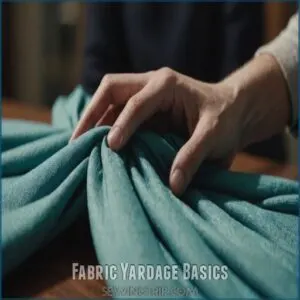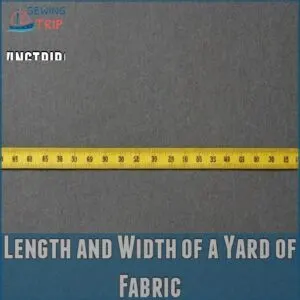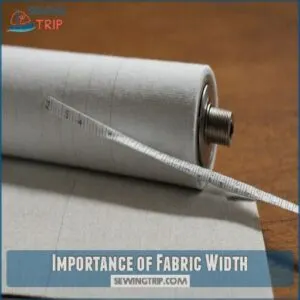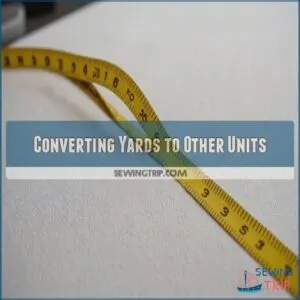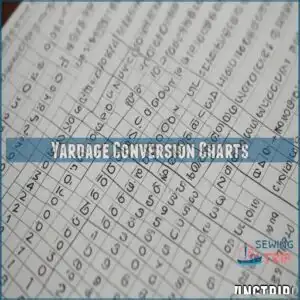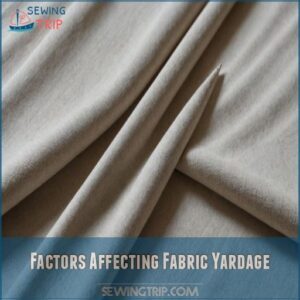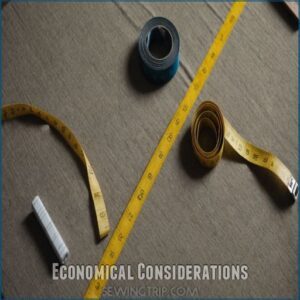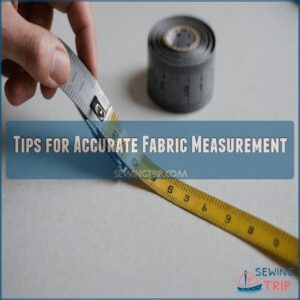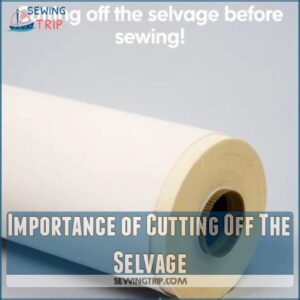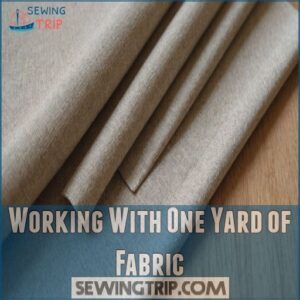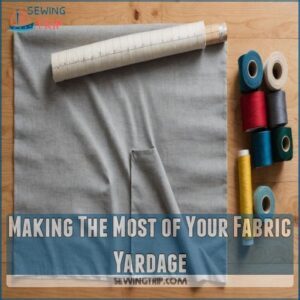This site is supported by our readers. We may earn a commission, at no cost to you, if you purchase through links.
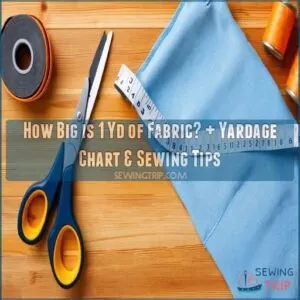 When you’re wondering "how big is 1 yd?" think of a yardstick from gym class.
When you’re wondering "how big is 1 yd?" think of a yardstick from gym class.
One yard equals 3 feet or 36 inches—about the length of a three-year-old stretching their arms wide!
In the metric world, it measures roughly 0.9144 meters, so slightly shy of a meter stick.
This standard unit, rooted in both the British imperial and U.S. customary systems, is versatile—from measuring your backyard to buying fabric for a crafty project.
For curious fabric enthusiasts, knowing how to sew hacks, such as using a fork to gather fabric, can greatly improve sewing accuracy and efficiency. For curious fabric enthusiasts, this is just the tip of the sewing needle.
Discover more about how yardage shapes your creative endeavors!
Table Of Contents
- Key Takeaways
- Fabric Yardage Basics
- Yardage Dimensions Explained
- Converting Yards to Other Units
- Yardage Conversion Charts
- Factors Affecting Fabric Yardage
- Economical Considerations
- Measuring and Cutting Fabric
- Working With One Yard of Fabric
- Making The Most of Your Fabric Yardage
- Frequently Asked Questions (FAQs)
- Conclusion
Key Takeaways
- When working with fabric, it’s crucial to have the right tools, such as quality fabric shears, to ensure accurate cuts. You’ll find that 1 yard equals 36 inches or 3 feet, making it essential for measuring fabric and other materials.
- Always check fabric width, which can vary significantly from 28 to 60 inches and impact your project and yardage calculations.
- Converting yards to metric is straightforward: 1 yard is approximately 0.9144 meters, handy for international projects.
- Efficient pattern placement can minimize fabric waste, saving you money and optimizing the use of your yardage.
Fabric Yardage Basics
When you’re eyeing that roll of fabric, a yard is your trusty standard—it’s 36 inches long.
But remember, the width can vary, so always check it like you’d double-check the oven for cookies.
What is a Yard of Fabric?
Imagine standing at the fabric store, wondering, "How big is a yard of fabric?"
It’s three feet of creative possibilities!
Typically, it runs 36 inches long and widths vary, impacting how much you need for projects, so check the fabric width affects yardage calculations to make sure you buy enough.
Consider fabric types too; lightweight cotton drapes differently than heavyweight denim.
Don’t forget to trim selvage for a neat, clean start!
How is Fabric Yardage Measured?
To unravel the mystery of fabric yardage, here’s how it’s measured:
- Length: Generally 36 inches, from your fingertips to your shoulder.
- Width: Varies with loom widths; from 28 to 60 inches.
- Measurement systems: Inches or meters, choose your style.
- Selvage removal: Snip the edges for precision.
You can find a helpful fabric yardage chart that breaks down yardage requirements for various sewing projects.
Remember, fabric types differ, so adapt accordingly!
Yardage Dimensions Explained
When you’re figuring out how much fabric to buy, it’s essential to know that a yard is 36 inches long.
Widths can vary wildly.
Think of the width like a secret ingredient in a recipe—it can make all the difference in your sewing project!
Length and Width of a Yard of Fabric
A yard is 36 inches long, offering flexibility in fabric projects.
But the width? Not a strict rule there.
Fabric widths vary from a snug 28 inches to a roomy 60, like choosing jeans—regular or wide-fit.
Width impacts your pattern placement and cost, so always check.
Want seats with little waste? Pick wisely!
Importance of Fabric Width
Fabric width has a big impact on your project.
Someone might think it’s just a number, but it’s really important!
Consider these points:
- Project size: Wider fabric often means fewer seams.
- Pattern placement: A wider cut reduces wasted fabric.
- Waste reduction: Efficient cutting saves you money.
- Fabric choice: Some fabrics are naturally narrower. Knowing this helps you plan. Choosing the right width saves you headaches (and fabric!).
Converting Yards to Other Units
Understanding fabric yardage conversions can feel like solving a puzzle, but it’s actually a piece of cake!
You’ll see how a yard magically transforms into feet, inches, meters, and centimeters, making it easier to plan your sewing projects with precision.
Yards to Feet and Inches
When you’re pulling out a tape measure, yardage conversions are pretty straightforward.
Think of a yard like an old friend: always 36 inches long.
So, when you convert yard to feet, that’s three feet.
Need to plan your fabric adventure?
Use this simple measurement guide to turn feet into inches, making fabric length calculations a breeze!
Yards to Meters and Centimeters
Understanding yards in metric terms can seem tricky, but it’s a breeze once you get it.
- Meter to yard: Just multiply by 0.9144.
- Centimeter to yard: Divide by 91.44.
- Think of yardage for international projects by using metricage calculations.
- Remember, fabric width in meters adds to your planning game.
Explore new possibilities with these conversions!
Yardage Conversion Charts
Ever found yourself in a fabric store wondering how many yards you need for that perfect project?
A yardage conversion chart is your go-to solution, helping you accurately translate between yards, feet, inches, and even meters without any hassle.
Using a Yardage Conversion Chart
Got a sewing project planned?
A yardage conversion chart keeps your fabric calculations on point, especially when working with specific fabric widths, like the standard 44 inches found in most fabric stores and measurements.
Picture it like a trusty sidekick in quilt yardage and project planning.
Check out this handy chart:
| Yards | Feet | Inches |
|---|---|---|
| 1 | 3 | 36 |
| 0.5 | 1.5 | 18 |
| 0.25 | 0.75 | 9 |
| 1.5 | 4.5 | 54 |
It’s your new best friend for sewing patterns and garment design!
Importance of Meterage Conversion Charts
Moving from yardage to meterage conversions can feel like switching from inches to centimeters when baking with international recipes.
Understanding metric sewing measurements is handy, especially for international projects or global fabric shopping.
Meterage conversion charts can help compare fabric sizes efficiently, ensuring your project goes smoothly, no matter where your fabric hails from.
Happy sewing!
Factors Affecting Fabric Yardage
So, you’re ready to tackle that sewing project, but figuring out how much fabric you need can be tricky!
Actually, several things affect how much yardage you’ll need, like the fabric type itself and how carefully you measure and cut.
Fabric Type and Yardage Requirements
When picking fabric, remember different types need different yardage.
Fabric weight, stretch, and your project’s size all play a part.
Loose, stretchy knits devour more fabric than stiff cotton.
Consider garment complexity with:
- Pattern pieces: More pieces, more fabric.
- Fabric weight: Heavier weights need more yardage.
- Fabric stretch: Stretch limits yardage for stable shapes.
Straightness and Accurate Yardage Calculations
Aligning fabric straight is like finding calm in chaos—start with removing that pesky selvage.
Use your measuring tools wisely; they’re the GPS for your sewing journey.
Remember, a yard of fabric can contain up to 11,000 individual threads, depending on the fabric measurements.
Accurate yardage calculations connect the dots for pattern placement, trimming fabric waste like a pro chef.
Think of this as fabric yoga—stretch, measure, and snip your way to serenity.
Economical Considerations
Choosing wider fabric can be a smart move for your wallet, letting you cut costs by squeezing more pattern pieces from each yard.
Efficient pattern placement helps you minimize waste and save money, making your projects beautiful and budget-friendly too!
Wider Fabric is More Economical
Think about fabric costs like you’d budget a meal.
Wider fabric ends up being the better deal, similar to buying groceries in bulk.
You get more bang for your buck, allowing efficient use for big or small projects alike.
If you’re unsure about the standard width of fabric, you can check out this helpful fabric width chart for a quick reference.
More fabric on the roll means less frequent trips to the store and, ultimately, more creative freedom with your designs.
Minimizing Waste With Efficient Pattern Placement
Wider fabric has its perks, but smart pattern placement is where the magic happens.
You’re not just cutting; you’re strategizing to save fabric.
Place patterns close, consider the grain alignment, and keep your scissors ready for some precise work.
- Pattern layout tips: Maximize every inch
- Fabric grain alignment: Helps in achieving clean cuts
- Waste reduction techniques: Reduce fabric scraps
Measuring and Cutting Fabric
When you’re measuring and cutting fabric, accuracy is your best friend; a minor slip can turn that perfect project into a head scratcher.
Always remember to cut off the selvage for a clean start—it’s like trimming off the crusts of a sandwich, except your sewing machine will thank you.
Tips for Accurate Fabric Measurement
Before you start cutting, grab your trusty measuring tape!
Accurate measurements require understanding fabric yardage, including how many inches are in a half yard of fabric half yard fabric calculations. Accurate measurements are key for successful sewing.
Check your fabric width; it impacts pattern placement.
| Tool | Use | Measurement Type | Accuracy Tip |
|---|---|---|---|
| Measuring Tape | Measuring fabric length and width | Linear | Double-check your measurements! |
| Ruler | Precise measurements for small pieces | Linear | Use a clear, marked ruler |
| Fabric Square | Checking for 90-degree angles | Angular | Make sure corners are perfectly square |
| Pattern Pieces | Guiding fabric cutting | Pattern Placement | Pin patterns securely before cutting |
Importance of Cutting Off The Selvage
You’ve nailed accurate measurements, but don’t skip cutting off the selvage.
Those selvage edges, often tighter and tougher, can mess up pattern placement and cause puckering.
Free those edges like they’re dancing out of the spotlight!
When working with fabric, it’s also essential to identify the grain by gently tugging the fabric on the bias, as explained in Fabric Preparation Basics.
- Prewash fabric to prevent surprises.
- Use sharp scissors or a rotary cutter.
- Check grain alignment.
- Leave a bit extra for patterns.
- Embrace the straight line.
Working With One Yard of Fabric
Working with just one yard of fabric challenges your creativity and resourcefulness, but it’s like solving a fun puzzle.
It’s amazing how many things you can make with it—from simple pillow covers to cute toddler outfits—proving that less can definitely be more!
One Yard Sewing Projects and Ideas
Looking for one-yard project inspiration?
Think about making toddler pants, cute baby bibs, or eye-catching pillow covers.
With fabric choices for small projects, you can save bucks and score big on creativity!
You won’t need to be a sewing whiz either; these beginner-friendly ideas are perfect for upcycling with one yard.
When it comes to redoing a room, consider repurposing old clothes or household items into new projects, like an upcycled fabric wall hanging or a patchwork rug made from repurposed fabric scraps. They’re straightforward, budget-friendly sewing projects to spruce things up!
Maximizing Fabric Usage in Small Projects
Think you’re stuck with a yard? Think again.
For inspiration on what to do with leftover fabric, check out websites selling products for fabric scraps projects.
Here’s how to make the most of it:
- Pattern placement: Optimize fabric use by placing patterns close together.
- Scrap fabric use: Turn leftovers into pockets or appliques.
- Project planning: Plan projects that maximize small fabric pieces.
- Efficient cutting: Use a rotary cutter for accuracy and speed.
Make your yard count!
Making The Most of Your Fabric Yardage
When you’re knee-deep in fabric, making the most of your yardage can save you time, money, and a bit of sanity.
By buying a little extra fabric for matching patterns and using a rotary cutter for precision, you’ll stretch your materials further and avoid any sewing mishaps.
Buying Extra Fabric for Matching Patterns
When buying fabric, it’s wise to snag a little extra for pattern matching.
Think of it like planning a scenic route for a road trip—you want the stripes to align and the print direction to pop without detours.
By accounting for repeat size, you’ll reduce fabric waste and achieve that seamless, professional finish in your projects.
Using a Rotary Cutter for Efficient Cutting
Many sewers swear by a rotary cutter for precise cuts.
It’s like having a tiny, super-sharp pizza cutter for fabric!
For efficient cutting, use a self-healing mat and a ruler.
When working with rotary cutters, using a sharp blade is crucial for precise cuts and safety, and rotary cutter blade sizes can vary for different tasks. Remember rotary cutter safety: keep your fingers clear.
This technique works wonders on various fabric types, from delicate silks to sturdy cottons, and is especially useful when working with patterns that include notches for alignment, making project planning a breeze.
Practice makes perfect! You’ll soon be cutting like a pro.
Frequently Asked Questions (FAQs)
How many inches in 1 yd?
One yard is 36 inches long, about the stride of a giraffe.
It’s a handy measure for fabric and fun projects.
Picture three rulers end-to-end—perfect for sewing, crafting, or getting your art groove on!
How big is one yard?
Imagine your favorite superhero cape, stretching from your shoulder to the ground.
That’s a yard—36 inches long, perfect for crafting or decorating.
Whether you’re sewing or measuring, it’s a unit you’ll often encounter in fabric stores.
How many yards in 1 m?
To convert meters to yards, remember that 1 meter equals about 094 yards.
Picture it like juggling: just a bit over a yard makes up a meter!
Now you can easily switch between them without a hiccup.
How many feet in a yard?
A yard stretches as long as a giant’s stride, equating to 3 feet.
Picture laying down three rulers end-to-end – that’s your yard!
It’s the same magic number whether you’re measuring fabric or garden paths.
How does fabric weight affect yardage?
Heavier fabrics, like denim, need less yardage for the same garment than lighter ones, like chiffon.
Think of it like this: a heavy coat uses less fabric than a flowy summer dress.
It’s all about the drape!
What is the average cost of one yard?
The cost of one yard of fabric typically ranges from $5 to $50, depending on material and quality.
Specialty fabrics can cost even more.
Always check sales or discounts for better deals, saving you some cash!
How to store leftover fabric efficiently?
Roll your leftover fabric neatly and secure with a rubber band for easy access.
Store in clear bins or hang on skirt hangers.
Use small scraps for quilting or patchwork.
Keep them organized by size or color.
Are there eco-friendly fabric options available?
Imagine crafting projects that save the planet!
You can choose eco-friendly fabrics like organic cotton, bamboo, and hemp.
These materials are sustainably produced, ditch harmful chemicals, and offer the perfect blend of responsibility and creativity.
How to choose the right fabric type?
Consider your project’s end-use, durability needs, and fabric care when choosing materials.
Opt for cotton for breathability, silk for luxury, or wool for warmth.
Test fabric drape and texture against your skin to avoid surprises.
Conclusion
Picture your creative projects unfolding with just one yard of fabric! You’ve learned that 1 yd is 36 inches or about 0.9144 meters long.
With tips on measuring and cutting, you can stretch your yardage like a seamstress with a magic wand.
Whether converting yards to meters or tackling a sewing project, you’re now equipped to handle fabric with finesse.
So go ahead, wield your newfound skills and make that humble yard truly work wonders!

